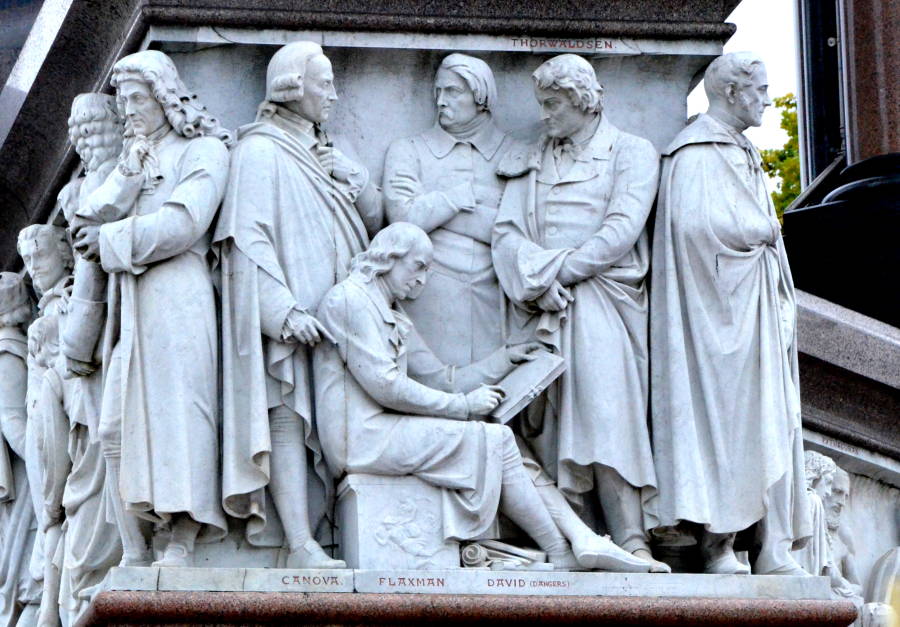
Bradley and Pevsner attribute the friezes on the base of the memorial to both H. H. Armstead and J. Birnie Philip, but do not identify creators of specific ones. John Lucas Tupper's 1872 essay on Armstead, however, states that Armstead created those representing the great — that is, the canonical — poets, composers, and painters in the Western tradition, leaving the remainder, one assumes, for Philip: “The podium of the Albert Memorial may be described as a cube with the angles cut off, and solid oblongs affixed to the cut surfaces. Here are, therefore, sixteen upright surfaces. Eight of these, entrusted to the chisel of Mr. Armstead, are dedicated to Poetry, Music, and Painting; without reference to the wings, which necessarily stand obliqluely; these are the south and east surfaces, containing eighty life-size figures.” Information about the dates and activities of the sculptors depicted comes from both Britannica and Wikipedia; the latter's article, “The Frieze of Parnassus” proved especially helpful. [Click on photographs to enlarge them.]

Left to right: Andrea del Verrochio (c. 1435–1488), Donatello [Donato di Niccolò di Betto Bardi] (c. 1386-1466), Michaelangelo di Lodovico Buonarroti Simoni (1475-1564), Pietro Torrigiano (1471-1528), Gian di Bologna [Jean Boulogne] (1529-1608). Michaelangelo, who has the honor of appearing in twice (amidst both the painters and sculptors) holds one of his works and sits before his Medici Tombs in Florence.

Left to right: Bartolommeo Bandinelli (1493-1560), Peter Vischer the Elder (c. 1455-1529), Benvenuto Cellini (1500-71), Baccio d'Agnolo (1462-1543), Jean Goujon (c.1510–after 1572), and Bernard Palissy (c.1519-c.1589).

Left to right: Niccola Pisano (c.1220-c.1284), Lucca della Robbia (1399/1400-1482), Benvenuto Cellini (1500-71), William of Ireland (fl. 1290), Andrea del Verrochio (c. 1435–1488), and Donatello [Donato di Niccolò di Betto Bardi] (c. 1386-1466). Lucca della Robbia sits closely inspecting one of the panels from Donatello's famous bronze doors on the Baptistery in Florence.

Left to right: Germain Pilon (c. 1537-1590), Nicholas Stone (c. 1586-1647), Gian Lorenzo Bernini (1598-1680), Caius Gabriel Cibber (1630–1700), Pierre Paul Puget (1620-1694), John Gibbons (1648-1721), Bird (), John Bushnell (d.1790), and Louis-François Roubillac (c.1705-62).

Left to right: Antonio Canova (1757-1820), John Flaxman (1755-1826), Pierre-Jean David d'Angers (1788-1856), Bertel Thorvaldsen (1770-1844). Flaxman also appears on the Victoria and Albert Museum's façade, which provides a pantheon of British artists, sculptors, and artisans.
Photograph, formatting, caption, and perspective correction by the author. You may use these images without prior permission for any scholarly or educational purpose as long as you (1) credit the photographer and (2) link your document to this URL in a web document or cite the Victorian Web in a print one.]
Bibliography
Tupper, J. L. “Henry Hugh Armstead,” English Artists of the Present Day. Essays” by J. Beavington Atkinson, Sidney Colvin, F. G. Stephens, Tom Taylor, and John L. Tupper. London: Seeley, Jackson, and Halliday, 1872, 61-66.
Pevsner, Nikolaus. Berkshire. London: Penguin, 1988.
Last modified 12 November 2011